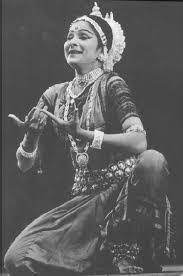I have always compared the art of her performance with the art of writing elegant hieroglyphs. You could sense the mystery and see the beauty of complete submission to the Supreme. Because Odissi has been born at the divine and Sanjukta’s oeuvre brought the heavens closer. Many believe that she was an embodiment of Radhadasis symbolising the highest degree of pure and selfless love towards Jagannath.
An outstanding exponent – and virtually the rediscoverer of Odissi dance, it was as if waiting to be disseminated globally through her.
Julia Varley, an acclaimed theatre actress of Odin Teatret, Denmark fame, called her “the dancer for the Gods”. Such was Sanjukta’s immersion with the art form, herself and the elements (five elements or panchabhutas).
She was the first girl to pursue Odissi dance as a career, honing the skills under the tutelage of guru Kelucharan Mahapatra, besides being trained in Bharata Natyam for six years with the master Rukmini Devi, and built its international profile at the highest cultural podiums of the world.

Sanjukta and dance were born together as inseparable. At eight, her victory in the International Children’s Film Festival defined the purpose of her life. Early as a little girl she was a celebrity, well known in the state as ‘baby Sanjukta”, and in 1967 she exploded on the national and international scene with the rare combination of dance styles. The fixed clear steps, equally poised in a combination of movements of a soloist and an ensemble, resulting in a holistic composition took Indian classical dance to new heights. The gestures and movements symbolizing feelings and moods were extolled as surreal.
In an interview she had said once, “I can dance all my life… I can bear anything if I am allowed to dance,”. Mention of awards, in her remembrance, would diminish her. Dance was her life, not a mere vocation. Sanjukta’s first public performance was when she was five and, in the event, she was given a five minutes’ slot. She was so lost in the dance and the nonstop applause that she continued without stopping even after promptings by her mother and guruji.

In 1977, Sanjukta presented her performance at a seminar in Holstebro, Denmark. She presented in a white costume and also gave a work demonstration to the assembled audience. Julia wrote: “Her dance remains engraved in the memory of all those present as a magical apparition. Tage Larsen, one of the actors of Odin Teatret, after having seen her dance, spent the afternoon washing his car, with a reaction similar to that of Eleonora Duse who spent the night tidying up her room after having seen Adelaide Ristori on stage. He was under a lasting spell, bedazzled. The spectators who see Sanjukta’s Odissi dance remain strongly affected, ecstatic and enamoured. The word commonly used to try and explain the experience of a meeting with her is ‘beauty’. Sanjukta is incredibly beautiful on stage, in life, during rehearsals, discussing with her musicians, correcting the rhythm, smiling with her cheeky expression, thanking the public, kneeling before the God Jagannath, drinking her morning tea, entering the stage dressed in white, or shocking pink or orange, turquoise, teaching, making jokes, when she says at a symposium that she doesn’t like to speak in public, when she dances – Sanjukta is always the image of beauty itself.”
Women empowerment was not a cliché for her and she lived life on her terms. First Odia girl to take up professional dancing, she along with her guru Kelu babu and husband Pandit Raghunath Panigrahi built an institution that took Odisha and Odissi to all parts of the world, even in an era without developed communication technologies as today. It was sheer brilliance born out of unwavering passion and unparalleled dedication.

Sanjukta co-founded ISTA ( International School of Theatre Anthropology) along with Eugenio Barba along with other international artistes from Bali, Italy and France. She has always been the ‘queen’ of the ‘republic’ of ISTA and has always opened the works with one of her dances. She always acknowledged that the work of ISTA has given her a greater awareness of the principles concealed behind the blindly accepted rules of her tradition. A thinking, intelligent performer like her assimilated in international cohorts which also gave her the window and reach to explore herself.
Hailing from Odisha in the seventies, she was immediately accepted and celebrated worldwide as a woman of substance, and she enjoyed her true felicitation. Probably the complexity and pettiness of art appreciation exasperated her and she could be on her own, more expansive at ISTA and other global platforms. Her art was meant for humanity, all over. Her choreographed ballets Raag Roop (depicting four emotional phases of woman in love), Ekhond Kandichhe Radha, Mangal Charan, Jagannath Astakam, Shiva Hanuman Strotam, Titu Varana and Astha Nayika enthralled the world.

Both Sanjukta and Raghunath Panigrahi made a terrific and rare arty team. The Padma awardees had jointly received the Sangeet Natak Academy Award too. They have won many more awards and accolades.
Sanjukta Panigrahi, unarguably the greatest-ever Odissi dancer, helped classical Indian dance re-position itself as one of the world’s oldest dance traditions, based on a connection between life and the larger environment. Embodying religion, philosophy, and mythology, she presented the otherworldly beauty and a spiritual experience for the audience, without making it trite and cornball. She brought reverence for and dignity to Odissi which metamorphosed into a world art form, with her bells travelling far and wide.
Thank you Sanjukta Panigrahi, the global citizen.
(The views expressed in this article are those of the author and do not represent those of the website)


